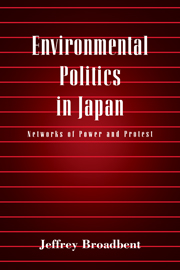Book contents
- Frontmatter
- Contents
- List of figures and tables
- Preface
- 1 Growth versus the environment in Japan
- 2 Visions and realities of growth
- 3 Protest and policy change
- 4 Movement startups
- 5 Protest against Landfill No. 8
- 6 Under the machine
- 7 The Governor gives in
- 8 Contested consensus
- 9 Pyrrhic victories
- 10 Power, protest, and political change
- Appendix 1 Meso-networks and macro-structures
- Appendix 2 Oita prefecture and Japan national growth and environmental key events: 1955–1980
- Appendix 3 Pollution legislation at prefectural and national levels, 1964–1985
- References
- Index
4 - Movement startups
Published online by Cambridge University Press: 12 January 2010
- Frontmatter
- Contents
- List of figures and tables
- Preface
- 1 Growth versus the environment in Japan
- 2 Visions and realities of growth
- 3 Protest and policy change
- 4 Movement startups
- 5 Protest against Landfill No. 8
- 6 Under the machine
- 7 The Governor gives in
- 8 Contested consensus
- 9 Pyrrhic victories
- 10 Power, protest, and political change
- Appendix 1 Meso-networks and macro-structures
- Appendix 2 Oita prefecture and Japan national growth and environmental key events: 1955–1980
- Appendix 3 Pollution legislation at prefectural and national levels, 1964–1985
- References
- Index
Summary
The mobilization process
Oita Prefecture contributed its share of movements to Japan s rising tide of environmental protest. None of Oitas movements became as famous or as epoch-making as Mishima-Numazu or the four big pollution cases. But in their way, they typified the era. They faced situations similar to those faced by other movements around the country. Oitas New Industrial City factories were not the only cause for protest. In the 1950s and 1960s, many factories and power plants set up shop around the prefecture, mostly in easily accessible coastal towns such as Saeki, Usuki, and Nakatsu. Unhindered by pollution regulations, these factories and power plants threatened to or did pollute their surroundings. They provided the physical, environmental conditions that might generate a movement. This caused a mobilization potential. Actualizing that potential required group recruitment, discussion, organizing, and strategizing (Klandermans & Tarrow, 1988).
This chapter and the next look at eight communities along the shore of Oita s industrial projects. Some mobilized and fielded fierce resistance, while others did not. One produced a countermovement that tried to nullify the staunch antipollution movement in the neighboring hamlet. How to account for the difference? Why did some of the Oita communities suffering from pollution (or its imminent threat) produce a protest movement and others not? An existing physical threat or deprivation alone is not enough to spur protest (Tarrow, 1994, p. 51). Pollution or other harm may cause unhappiness or bitterness in many individuals, but this may result only in a mobilization potential, not mobilization itself. Environmental devastation afflicted a number of Oita communities without setting off protest.
- Type
- Chapter
- Information
- Environmental Politics in JapanNetworks of Power and Protest, pp. 134 - 153Publisher: Cambridge University PressPrint publication year: 1998

